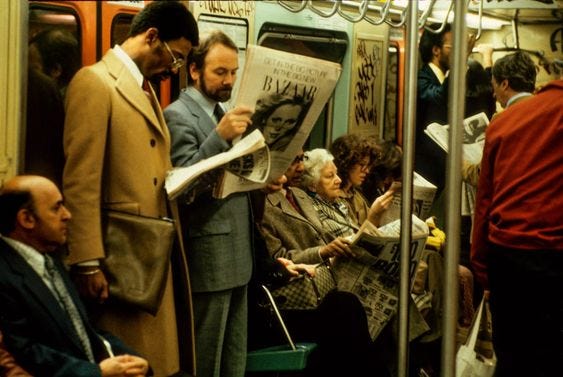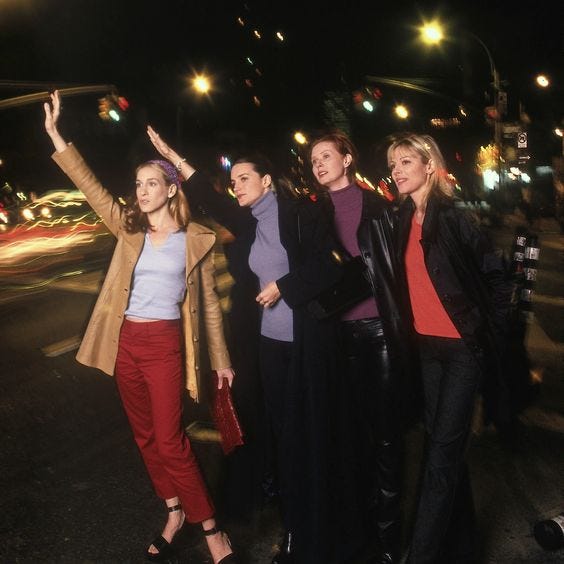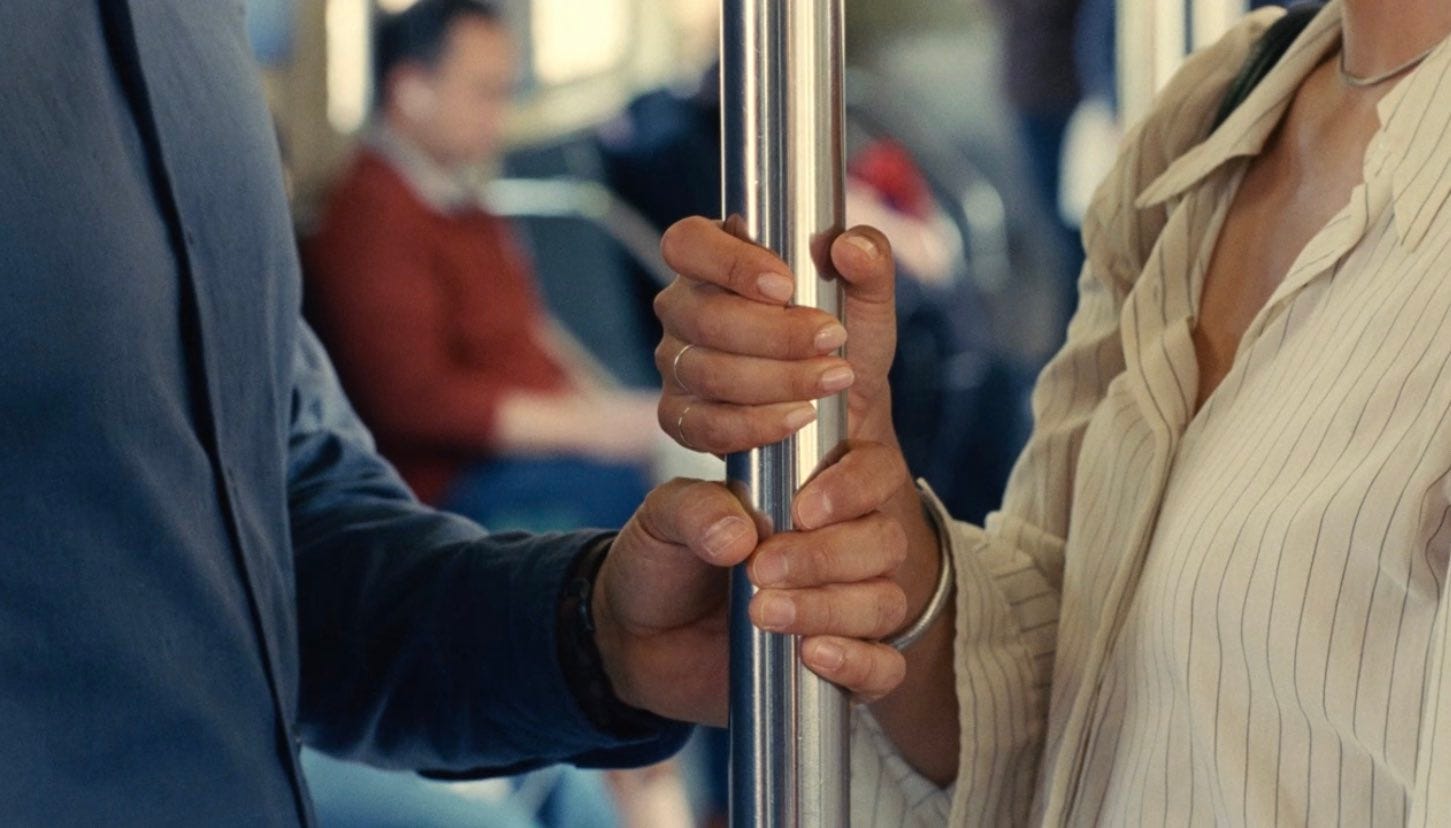We’re Following Social Conventions Too Well
A Love Letter to NYC, But Mainly Forced Intimacy
The tables at restaurants in New York City are much too close together, which is my favorite and least favorite thing about them. There’s a real provocative chord underlining how physically and forcibly close we’re all made to be in the city - hands brush on the subway poles, shoulders clip one another on narrow streets, eye contact is made and quickly averted on the train platform. Even crossing the street with another person has a degree of intimacy - both of us step off the curb and peer our heads down the one-way road in unison, crossing together in time. We may as well be holding hands. City dwellers are dogpiled atop one another, intertwined with each other’s business whether they want to be or not. Perhaps I’m still too green here, but I revel in being adjacent to others’ drama.
The other day I “wrote” in a bakery next to my apartment, which is to say I sat in a bakery with my laptop open and listened to others’ conversations. There is seating for approximately nine people inside when squeezed hip-to-hip. This tight proximity paired with the intoxicating aroma of butter and cardamom makes the environment far too distracting to write. So I listen, looking intently at my Google Doc, so people don’t think I am.
Two elementary-aged girls tumble into the bakery with too-big backpacks and a mother figure who purchases them a cinnamon roll to share before school (lucky!). They lick the sugar off their fingertips and swing their legs from the chair - they’re too far away for me to hear their conversation. A millennial couple in matching black athleisure strides in, a golden retriever in tow with fur so blonde it's practically white. The dog’s tail, as soft-looking as a feather, wags back and forth, almost grazing my leg. A twenty-something man and woman sit next to me with their coffees and egg sandwiches and begin talking - catching up it seems. As the woman tells the man about her upcoming girls' trip to Portugal, I try to discern their relationship - they appear too nervous around each other to be siblings, but not affectionate enough to be a couple. Maybe they’re in the early stages of dating, or maybe they're just friends, and I’m reading into the nervous energy too much. Perhaps they’ll date later in life, perhaps their relationship will fizzle - who am I to know? When a seat across the bakery opens, they relocate there so they don’t have to sit so close to me, which is disappointing. But I can’t fully blame them - I would do the same.
It’s difficult to talk so freely when you know someone is listening. I don’t understand how others speak so unabashedly. Once in a silent subway car, a girl next to me loudly announced to her acquaintance that her brother had recently committed suicide - not a waver in her tone. The subway car inhabitants, now inadvertently stewards of this information, continued their commute, didn’t pay her an ounce of mind - and why would they? Taking public transportation means sharing public space and thus bearing witness to conversations between people in public. It’s the silent contract we enter when we cross the turnstile. Yet, my voice naturally quiets as I divulge life updates and intimate thoughts in public. My interlocutor lurches across the cafe table with a furrowed brow - I can’t hear you. I relish listening to and quietly speculating others’ life details but shiver at the thought of someone doing the same to me.
People in Seattle, my hometown, are marked by the reputation of being frigid. The “Seattle Freeze” was first dubbed in The Seattle Times in 2005, referring to the excess amount of politeness that Seattleites possess in place of friendliness. Like a plastic Barbie smile, there is an air of kindness, but what’s underneath can be, at times, hollow. People in Seattle never honk their horns. At a four-way stop, you’ll be met with waves from standstill drivers, urging you to Go ahead!, even if you arrive at the light last. Someone may hold the elevator door open for you for a beat too long. But when it comes time to exchange names, and perhaps make plans to hang out, the iciness spreads all over in a thick sheet. People are known for canceling plans, for exchanging pleasantries at parties and little more. When people have conflict with others, they don’t confront it, they shrivel into their caves and allow the friendship to quietly decay. There is a collective distaste for intimacy, and a desire to hole up under the covers, likely influenced by the uninviting, damp weather, and the swath of tech jobs that have overtaken the city - a city once primarily known for its alternative creativity. Kindness without closeness, icing without cake.
I must provide the disclaimer that there are, of course, exceptions to this. Seattle is also one of my favorite places in the world and contains some of the people I love the most in my life - I will hopefully live there again full-time. I have found great pockets of connection there. But I will admit that its dwellers tend to like traversing life alone. I am a product of Seattle’s frigidity, which is likely why I find the warmth of other cities so novel. It’s perhaps why I’m also more keen to play bystander than active participant.
Many are drawn to New York City for the kind of “main character” feeling that it exudes. Walking down the streets and feeling the subway wind whip your face feels cinematic because those are the kinds of experiences we’re used to watching in movies, and more recently, vlogs and TikToks. While there is a dazzling feeling to simulating Carrie Bradshaw as you hail a cab, what these various media types are actually capturing - at an elemental level - is the romance and humility found in close quarters and reliance on public transportation. When it comes down to it, what many of these people are likely really craving is necessitated intimacy.
Around two or three o’clock in the afternoon, I’ll take a stroll around my neighborhood after being confined to my laptop screen for hours on end. The sheer sight and sound of many people walking on the street shocks my system. It energizes me, keeping me on alert for persons of interest as I mosey down the sidewalk. As I walk, I nod and smile at business owners and patrons I’ve bumped into before. I’m grateful to have close, intimate friends in my life, but I’ve cultivated a more quiet intimacy with these “weak ties” - these acquaintances that I see more than I speak to. They make me feel like I’m a part of the greater world, rather than just my inner circle, and perhaps I do the same for them.
The walkable arrangement of the city is reminiscent of a college town - grocery stores and train stops within walking distance, substantial sidewalks, familiar faces. And, unfortunately, it is such a novel arrangement to come across in the United States, where so many cities are partial to cars. In his book Encounterism: the Neglected Joys of Being in Person, writer and artist Andy Field critiques the “frictionless” design of contemporary cities, which dissuades lingering and chance encounters, and thus empathy - in some capacity - for strangers. Modern city design has long been cited as a reason for heightened feelings of loneliness and isolation.
I don’t think we all necessarily need to flock to metropolitan hubs if we don’t desire to. While walkable communities help facilitate connection, this is as much a study of city design as it is of the intention behind human interaction. We will never be without other humans - never truly. Even if it’s just the mailman or the passerby in Trader Joe’s. To walk into a room with intention is to look people squarely in their eyes, to listen to what they say (even eavesdropping sometimes), and acknowledge their presence - with a smile, with a nod, with a question, with a laugh. These are all behaviors we can act out as we pass through life, as we perform our routine and novel interactions.
Sure, it’s a kitschy, fuzzy statement - that passing someone a smile can make you feel more connected to your world. That getting off your phone as you wait in line will help you feel more physically integrated into your space. It’s obvious. Yet, increasingly, we keep to ourselves. We don’t jump into others’ conversations at parties. We don’t ask questions to strangers. And we feel as though it's harder to find friends and romantic partners. We might all be following social conventions a little too closely. This is, in part, likely out of concern for physical and emotional safety and a desire to not waste time on meaningless interactions - a quality that’s been bolstered by “optimization” culture on social media, namely dating and friendship advice delivered via TikTok. We avoid “red flags,” we protect our peace, and accordingly, we shut off the possibility of interesting and disappointing interactions - each of which is meaningful in its own right. In her great essay defending dance floor make-outs,
astutely writes:“our phones have slowly enabled us to put up cushy padded walls up under the guise of self-help and betterment when in reality what we should be prioritizing is learning more about ourselves through soaking up experiences that span from uncomfortable to euphorically buoyant...”
As with anything, there’s a line to avoid crossing to ensure people feel safe - but maybe we should all feel a bit more uncomfortable in our skin. Maybe we should lean more into what’s now considered socially taboo.
I once heard a funny stand-up comedy bit that a woman could be having the best day of her life but sit on the subway with a committed look of unequivocal sadness. This is my experience too. On the train, I often put on a hardened, solemn facial expression to avoid being approached, or worse, harassed, and I often notice others doing the same. I wonder how many of them are actually serious and how many of them are adopting the same strategy as me. Glancing around, I notice people let this facade crack - a woman is quietly crying into her hands, a man is hollering, friends are laughing, and a child is dancing. There’s a rhythm that moves through us, we’re all complimenting or contradicting the energy of one another. It’s exhilarating to feel this hum of feeling running through people in a world where we’re so siloed off by our devices and social reservations. The hum is at times dull and other times crackling with fervor. We’re all quietly tending to one another by way of existing. It’s a joy to get to peek into their lives.
What I’ve learned over the past year and a half isn’t necessarily that I love New York City (and I do love it), but that I love people. I enjoy the quietness and solitude that can be found in great expanses of nature, and I also enjoy the tenderness that comes with sitting and standing near others living their lives. We would benefit from being a bit bolder with how we show up, striding with intention, kindness, curiosity, and an open spirit. The worst that will happen is a conventionally “ill” social interaction, which will inevitably make for good conversation with someone else that you bump into elsewhere. Listen a little closer and speak up a little more - the worst that will happen is someone will listen.








"Listen a little closer and speak up a little more - the worst that will happen is someone will listen."
this last sentence is wonderful. <3
a few months ago, during a catch up with my girlfriends over tacos and margaritas, one of them broke down and cried over the end of a long-term friendship. I feel like I've become quite German (having lived here for nearly 5 years) and balked at the idea of my American friend being so loud and emotional in public. 5 minutes later, the waitress came over with tequila shots for us, as she'd witnessed the pain being exchanged in the group. So you're right, sometimes people around us are listening, and most of the time, people around us are good and kind.
Have you seen “Sometimes I Think About Dying”? I think it beautifully captures something about the PNW’s socially anxious misanthropic loneliness and self-isolation. I have also found denser cities (first NYC and now, San Francisco) a beautiful form of exposure therapy to counteract my suburban Portland upbringing.